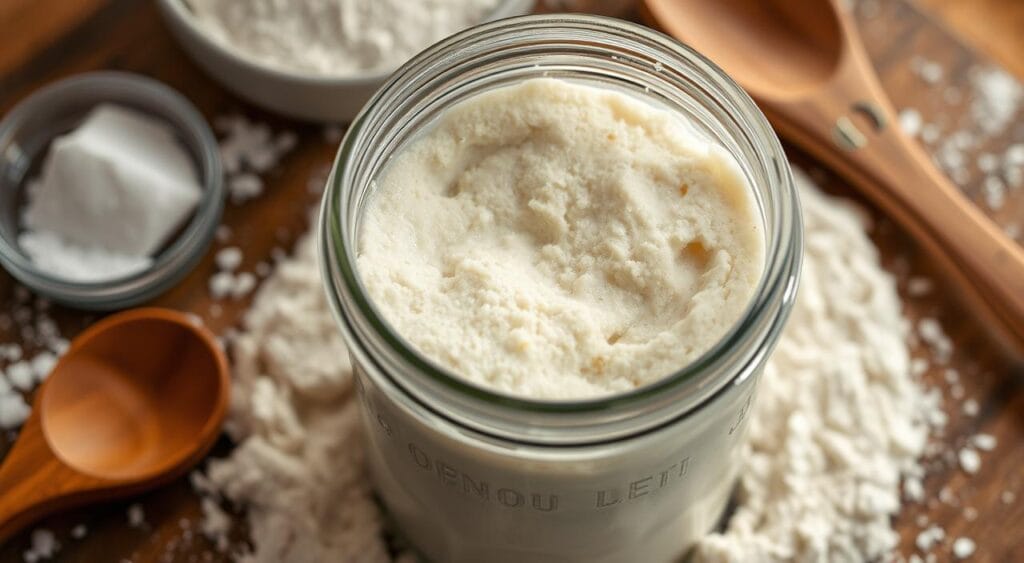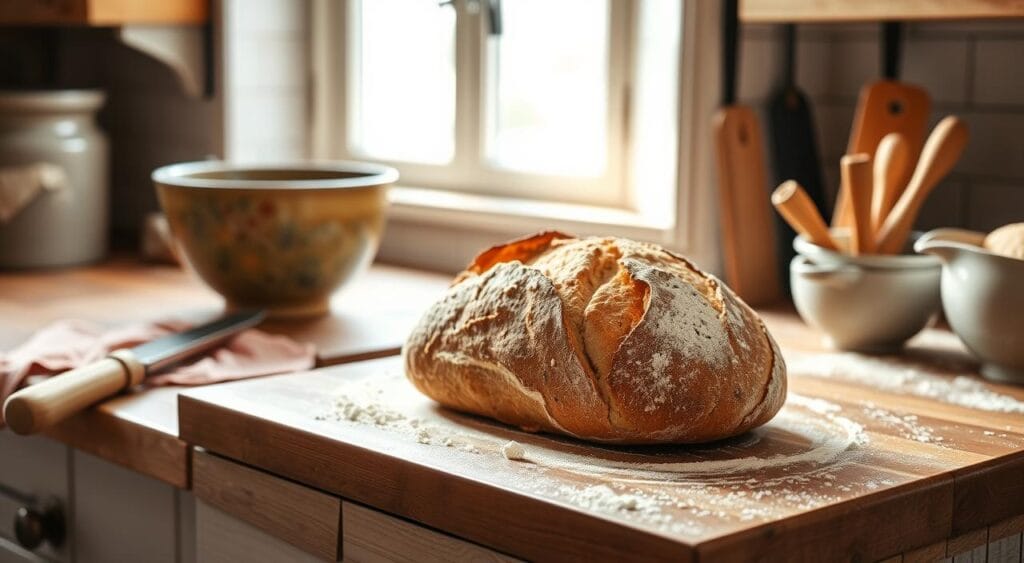Table of Contents
I love making artisan breads at home. The smell of sourdough bread baking is amazing. Today, I want to share a simple recipe for Sandwich Sourdough Bread Recipe. It will make your sandwiches special.
Making homemade bread might seem hard, but I’ll show you how. This recipe is for everyone, whether you’re experienced or new to baking. You’ll learn to make a beautiful, tasty sourdough bread.
Key Takeaways
- Discover a delicious sandwich sourdough bread recipe that’s easy to make at home
- Learn the key ingredients and techniques for baking an artisanal loaf of sourdough bread
- Explore the benefits of making your own homemade bread and the satisfaction it brings
- Understand the importance of the fermentation process and how to shape the perfect loaf
- Uncover tips for achieving a crisp crust and a soft, fluffy interior for your sourdough bread
Introduction to Sourdough Bread
Sourdough bread is a special kind of bread that has been loved for centuries. It’s different from regular bread because it uses a fermented starter. This starter gives sourdough its tangy taste and chewy texture. Making sourdough at home is a fun way to learn about bread making and enjoy a fresh loaf.
What is Sourdough Bread?
Sourdough bread is made with a special dough called a sourdough starter. This starter is a mix of flour and water that ferments. It’s home to natural yeasts and bacteria that make the bread tangy and chewy.
Benefits of Making Homemade Bread
- Enjoy a more nutritious and flavorful bread compared to store-bought options
- Control the ingredients and customize the recipe to your taste preferences
- Save money by baking your own bread at home
- Engage in a rewarding and therapeutic hobby
Key Ingredients You’ll Need
To make sourdough bread at home, you’ll need a few key ingredients:
- Sourdough Starter: A fermented mixture of flour and water that serves as the leavening agent.
- Bread Flour: A high-protein flour that helps create the desired chewy texture.
- Water: Necessary for hydrating the dough and activating the sourdough starter.
- Salt: Enhances the overall flavor and tightens the crumb structure.
“Baking bread is one of the most rewarding and satisfying experiences. The process of creating a delicious loaf from just a few simple ingredients is truly magical.”
Preparing Your Starter
At the heart of any great sourdough bread is the sourdough starter. It’s a living culture that starts the fermentation process. Knowing about this key ingredient is the first step to baking tasty, homemade loaves.
What is a Sourdough Starter?
A sourdough starter is a mix of flour and water that ferments over time. It grows wild yeast and good bacteria. This starter makes sourdough bread rise without commercial yeast. As it matures, it gets a special flavor that makes the bread unique.
How to Create Your Own Starter
- Start by mixing equal parts flour (whole wheat or all-purpose) and water in a clean jar or container.
- Cover it loosely and let it sit at room temperature for 24 hours.
- After 24 hours, throw away half and add fresh flour and water. Do this daily for 7-10 days, watching it grow and get active.
- When it doubles in size and smells sour, it’s ready to use.
Maintaining Your Starter
To keep your sourdough starter healthy, feed it regularly. Discard some and add fresh flour and water. How often depends on how much you use it. Feed it every 12-24 hours if daily, or once a week if stored in the fridge.
Learning about sourdough starters and caring for your own is key. You’ll soon bake delicious, homemade sourdough bread with a flavor all your own.
“The key to great sourdough bread is a strong, healthy starter. With a little patience and care, you can cultivate your own microbial powerhouse to unlock the full potential of your homemade loaves.”
Mixing the Dough
Making the perfect sourdough bread begins with mixing the dough. You’ll need a few key bread flour ingredients and the right tools. Follow these steps to bake a delicious, no-knead bread that will wow everyone.
Ingredients for the Dough
- Bread flour
- Sourdough starter
- Water
- Salt
Equipment You Will Need
- Large mixing bowl
- Wooden spoon or dough whisk
- Scale (for precise measurements)
- Dough scraper (optional, but helpful)
Step-by-Step Mixing Instructions
1. In your large mixing bowl, mix together the bread flour, sourdough starter, and water. You’ll get a shaggy dough.
2. Sprinkle salt over the dough. Use your hands or a dough whisk to mix it in well.
3. Cover the bowl with a damp towel or plastic wrap. Let the dough rest for 30 minutes. This step helps the gluten develop.
4. After resting, do a series of stretch and folds. Do this every 30 minutes for 2-3 hours.
5. When the dough is smooth and has grown, it’s ready for the next step.
“The key to mixing the perfect sourdough dough is to take your time and let the gluten develop naturally. Avoid the temptation to overwork the dough.”
By following these steps, you’ll make a strong, well-developedsourdough breaddough. Use high-qualitybread flour and stick to a no-knead method for the best results.
Fermentation Process
To make the best sourdough bread, you need to understand the fermentation process. This step is key for the bread’s flavor, texture, and smell. It makes sourdough special compared to other breads.
Understanding Bulk Fermentation
Bulk fermentation is the first step. It lets the dough rest and rise. This is when the sourdough starter’s yeast and bacteria work their magic. It builds the bread’s structure, flavors, and that sourdough tang.
How Long Should You Ferment?
- The right fermentation time depends on temperature, dough moisture, and starter strength.
- For a general guide, aim for 4-12 hours. Warmer places need less time, cooler ones more.
- Keep an eye on your dough to find the best time for your situation.
Signs Your Dough is Ready
- Increased Volume: The dough should have grown, doubling or tripling in size.
- Jiggle Test: Shake the dough gently. If it jiggles, it’s ready.
- Finger Poke: Poke the dough with your finger. If it springs back, it’s ready.
Understanding fermentation and knowing when your dough is ready will help you make perfect sourdough bread. The effort you put into this stage will result in a light, tasty, and textured loaf.

Shaping Your Loaf
Shaping your sourdough loaf is key to getting that perfect, rustic loaf look and feel. This guide will help you turn your dough into a stunning, bakery-quality loaf. You’ll learn how to shape and score your dough for the best results.
Techniques for Shaping Sourdough
The way you shape your sourdough loaf greatly affects its final look and taste. Learn a few essential shaping methods to find what works best for you:
- Coil folding: Coil the dough into a tight, round shape for a vertical rise.
- Stretch and fold: Stretch and fold the dough to build structure and strength.
- Batard shaping: Roll the dough into a cylindrical shape for a classic bread scoring look.
Scoring the Bread for Baking
After shaping, it’s time to score the dough. Scoring lets the bread expand and get that unique, artisan look. Try out different bread scoring patterns to find your favorite.
Scoring’s depth and angle impact the bread’s rise and crust. So, keep practicing. Soon, you’ll be making beautiful, rustic loaves like a pro.
Baking Your Sourdough
Mastering bread baking is more than mixing dough. It’s about the science behind a perfect bake. To get that perfect bread crust and crumb, consider a few key factors.
Choosing the Right Oven Temperature
The best oven temperature for sourdough is between 450°F and 500°F. This high heat creates a golden, sturdy bread crust. It also helps with oven spring and rise. Make sure your oven is preheated well before baking.
Baking Methods: Dutch Oven vs. Sheet Pan
There are two main baking methods: Dutch oven and sheet pan. A Dutch oven creates a steamy environment for a crisp bread crust. A sheet pan with water can also work well, mimicking Dutch oven steam.
How to Achieve a Crisp Crust
- Mist the oven walls with water at the start to create steam. This is key for a beautiful bread crust.
- Don’t open the oven door too often. This can lose valuable steam and affect bread baking.
- Lower the oven temperature towards the end to crisp up the bread crust.
By using these baking techniques, you’ll make exceptional homemade sourdough bread. It will have a great artisan bread texture and taste.

“The smell of freshly baked bread is one of the most comforting and inviting aromas in the world.”
Cooling & Storing Your Bread
After your homemade bread comes out of the oven, the real challenge starts. It’s important to cool and store it right to keep it fresh. This way, you can enjoy your bread crust for days.
Importance of Cooling
Let your homemade bread cool down completely before you slice or store it. This step helps the inside cook fully. Cutting into it too soon can make it gummy or dense.
Best Practices for Storage
When your bread crust is cool, it’s time to store it. For a short time, keep it in a paper bag or bread box. This keeps the crust crisp. Don’t use plastic bags, as they can make the bread soggy.
How to Freeze Sourdough Bread
To keep your homemade bread fresh for longer, freeze it. Wrap the cooled loaf in plastic wrap or foil, then in a freezer bag. Thaw it at room temperature before you slice and serve. Frozen sourdough stays fresh for up to three months.
Learning how to cool and store your homemade bread lets you enjoy it longer. With these tips, your sourdough will stay fresh for all your meals. Check out more recipes at this link.
Enjoying Your Sandwich Sourdough
Now that you’ve mastered the art of baking your own sandwich sourdough bread recipe, it’s time to explore the endless possibilities. From savory sandwich fillings to perfectly paired accompaniments, your homemade rustic loaf is the perfect canvas for culinary creativity.
Best Sandwich Fillings for Sourdough
The tangy, slightly sour flavor of sourdough bread pairs remarkably well with a variety of fillings. Consider classic combinations like sliced turkey, crisp bacon, and creamy avocado. For a vegetarian option, layer roasted vegetables, melty cheese, and a drizzle of balsamic glaze. Experiment with seasonal produce and bold condiments to create truly craveable sandwich masterpieces.
Pairing Suggestions for Your Bread
- Serve thick slices of your homemade sourdough alongside a hearty soup or stew for a comforting meal.
- Toast the bread and top it with creamy nut butter, fresh fruit, and a sprinkle of cinnamon for a satisfying breakfast.
- Use the sandwich sourdough bread recipe to make French toast or bread pudding for a decadent brunch treat.
- Enjoy a slice of your rustic loaf with a simple salad, drizzled with high-quality olive oil and balsamic vinegar.
No matter how you choose to enjoy your homemade sourdough bread, the key is to savor the unique flavor and texture. Experiment, have fun, and indulge in the delicious rewards of your baking efforts.
Troubleshooting Common Issues
Baking artisan bread can be rewarding, but you might face some challenges. If your bread doesn’t rise or feels denser than you want, don’t worry. There are solutions to help you get the perfect bread baking results.
Why is My Bread Not Rising?
If your sourdough loaf isn’t rising, it might be due to a few reasons. Make sure your artisan bread starter is healthy and active. This starter is key for the rise. Also, ensure your dough is fermenting well during the bulk stage.
Adjusting the temperature and fermentation time can help a lot. This can make your bread rise better.
Fixing a Dense Loaf
A dense, heavy sourdough bread can be a problem. Check if you’re overworking the dough. This can make the bread tight and dense.
Proper folding and shaping are important. They help develop the gluten and make the bread lighter. Try changing the hydration levels and baking methods, like using a bread baking stone or Dutch oven. This can improve the texture.
Tips for Improving Flavor and Texture
To make your sourdough bread taste and feel better, try extending the bulk fermentation time. This lets the flavors develop more. Also, changing the flour blend or adding different grains or mix-ins can add depth to the taste.
Proper storage is key too. Keep the bread in a paper bag or cloth. This helps keep the crust crisp and the inside soft and chewy.
FAQ
What is sourdough bread?
Sourdough bread is made with a sourdough starter. This starter is a mix of flour and water that ferments. It gives the bread a tangy taste and a chewy texture.
What are the benefits of making homemade sourdough bread?
Making sourdough at home lets you control the ingredients. You can also customize the flavor. Plus, homemade sourdough is healthier, with less sugar and more good bacteria.
What key ingredients are needed to make sourdough bread?
You need flour, water, salt, and a sourdough starter. The starter is what makes the bread rise.
What is a sourdough starter, and how do I create one?
A sourdough starter is a mix of flour and water that ferments. To make one, mix flour and water and let it sit for days. Feed it regularly to keep it alive.
How do I maintain my sourdough starter?
To keep your starter alive, feed it flour and water often. How often depends on how you use it. But usually, every 12-24 hours is best.
What equipment do I need to make sourdough bread?
You’ll need a big bowl, a bench scraper, and a Dutch oven or baking sheet. A razor or lame for scoring is also key. A digital scale and proofing basket can be helpful too.
How do I mix the sourdough dough?
Mix the starter with water, flour, and salt. The no-knead method is popular. Just mix and let the dough develop slowly over time.
How long should I ferment the sourdough dough?
Ferment the dough for 8-12 hours. The time depends on your starter’s strength and the temperature. Look for a doubled size and a bubbly, jiggly dough.
How do I shape the sourdough loaf?
Shape the dough by stretching and folding it. This builds its structure. Scoring the top with a razor or lame helps it expand evenly during baking.
What’s the best way to bake sourdough bread?
Bake in a preheated Dutch oven or on a baking stone for a crisp crust. High heat and steam in the oven are crucial for a perfect loaf.
How should I store and enjoy my homemade sourdough bread?
Cool the loaf completely before slicing and storing. Store it in a paper or cloth bag at room temperature. Avoid airtight containers to keep the crust crisp. Sourdough is great for sandwiches and toppings.
What should I do if my sourdough bread isn’t rising properly?
If the bread isn’t rising, check your starter. Make sure the dough is hydrated and the times are right for your environment. Adjusting these can help.

